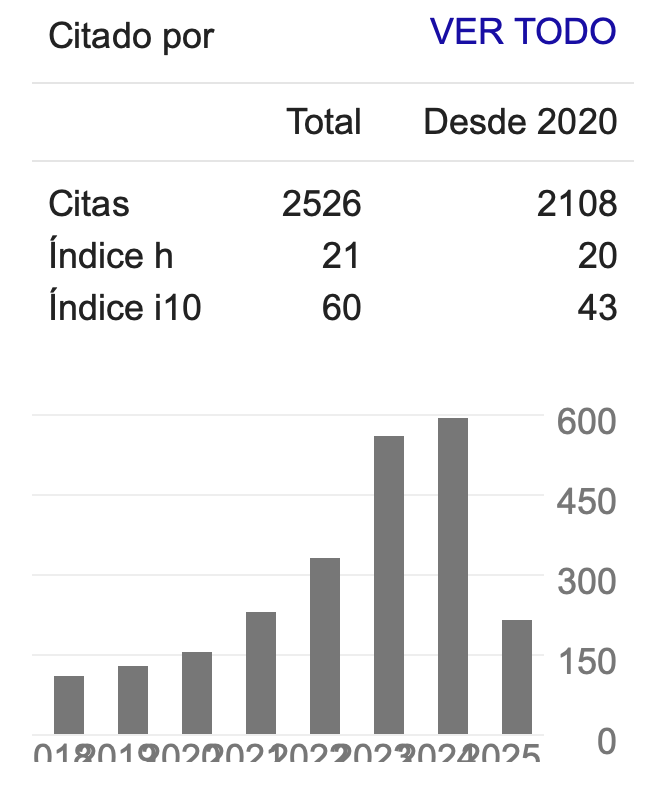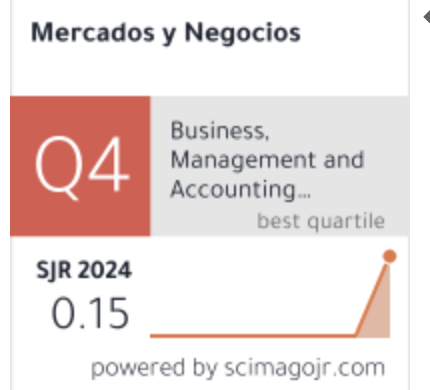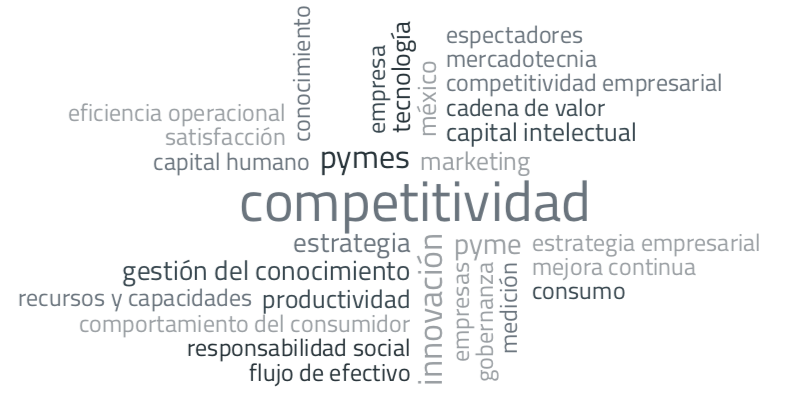Determinantes y modelos para medir el desempeño de una cadena de suministro agroalimentaria: una revisión de la literatura
DOI:
https://doi.org/10.32870/myn.v0i36.6646Keywords:
cadena de suministro agroalimentaria, desempeño, empresas, modelos, factores,Abstract
El propósito de esta investigación es identificar, a través de una revisión de la literatura, los factores determinantes y modelos que se utilizan con mayor frecuencia para medir el desempeño de la cadena de suministro agroalimentaria. A través de un método documental-exploratorio, en diversos trabajos de investigación, se logró identificar que la eficiencia, la capacidad de respuesta, la flexibilidad, la calidad del alimento y la calidad en el proceso, y los modelos determinísticos y de negocios son los que con frecuencia se utilizan para medir el desempeño de una cadena de suministro.References
Apaiah, R. (2006). Designing food supply chains- a estructured methodology: A case on novel protein foods. Wageningen: University of Wageningen, PhD Thesis.
Aramyan, L. (2007). Measuring supply chain performance in the agri-food sector. Wageningen: Wageningen University, PhD Thesis.
Aramyan, L., Ondersteijn, C., Van Kooten, O., & Lansink, A. (2006). Performance Indicators in Agri-food Production Chains. En C. Ondersteijn, J. Wijnands, R. Huirne, & O. Van Kooten, Quantifying the Agri-food Supply Chain (págs. 47-64). Wageningen: Springer.
Arana, J. (2010). Supply chain practices, performance and organizational configuration in the Mexican avocado industry. Wageningen: Wageningen University, PhD Thesis .
Armistead, C., & Mapes, J. (1993). The impact of supply chain integration on operatin performance. Logistics Information Management, 9-14.
Arntzen, B., Brown, G., Harrison, P., & Trafton, L. (1995). Global supply chain management at digital equipment corporation. Interfaces, 69-93.
Beamon, B. (1998). Supply chain design and analysis: models and methods. International Journal of Production Economics, 281-294.
Beamon, B. (1999). Measuring supply chain performance. International Journal of Operations & Production Management, 275-292.
Berry, D., & Naim, M. M. (1996). Quantifying the relative improvements of redesign strategies in P.C. supply chain. International Journal of Production Economics , 181-196.
Bhagwat, R., & Sharma, M. (2007). Performance measurement of supply chain management: A balanced scorecard approach. Computers and Industrial Engineering, 43-62.
Bijman, J. (2002). Essays on agricultural co-operatives, governance structure in fruit and vegentables chains . Rotterdam: Erasmus University, PhD Thesis.
Bititici, U., Cavalieri, S., & Cieminski, G. (2005). Implementation of Performance Measurement Systems: Private and Public Sectors. Production Planning and Control, 99-100.
Borges, J. (2004). Measuring performance in supply chain: A framework. Information Systems Journal, 1-6.
Bowersox, D., & Closs, D. (1996). Logistical management: the integrated supply chain process. New York: McGraw-Hill.
Bowersox, D., & Daugherty, P. (1995). Logistics paradigms: the impact of information technology. Journal of Business Logistics, 65-79.
Brewer, P., & Speh, T. (2000). Using the Balanced Scorecard to measure supply chain performance. Journal of Business Logistics, 21(1), 75-93.
Carlsson-Kanyama, A., Pipping Ekström, M., & Shanahan, H. (2003). Food and life cycle energy inputs: consequences of diet and ways to increase efficiency. Ecological Economics, 293-307.
Castañeda, T., Boucher, F., Sánchez, E., & Espinoza, A. (2009). La concentración de agroindustrias rurales de producción de quesos en el noroeste del Estado de México: un estudio de caracterización. Estudios Sociales (online), 73-109.
Chaowarut, W., Wanitwattanakosol, J., & Sopadang, A. (2009). A framework for performance measurement of supply chains in frozen food industries. Thai Researchers Consortium of Value Chain Management and Logistics Conference 2009 (págs. 98-108). Chiang Mai: VCML.
Collins, A., Henchion, M., & O´Reilly, P. (2001). Logistics customer service: performance of irish food exporters. International Journal of Retail and Distribution Management, 6-15.
Coelli, T., Prasada Rao, D., O´Donnell, C., & Battese, G. (2005). An introduction to efficiency and productivity analysis. New York: Springer.
Cohen, M., & Lee, H. (1988). Strategic analysis of integrated production-distribution systems: models and methods. Operations Research, 216-228.
Cohen, M., & Lee, H. (1989). Resource deployment analysis of global manufacturing and distribution networks. Journal of Manufacturing and Operations Management, 81-104.
Cohen, M., & Moon, S. (1990). Impact of production scale economies, manufacturing complexity and transportation costs on supply chain facility networks. Journal of Manufacturing and Operations Management, 269-292.
Cooper, R. (1988). The rise of Activity-Based Costing Part One: What is an Activity-Based Cost system? Journal of Cost Management, 45-54.
Cooper, R., & Kaplan, R. (1991). Profit Priorities from Activiy-Based Costing. Harvard Business Review, 130-135.
Chopra, S., & Meindl, P. (2001). Supply chain management: strategy, planning and operation. Nueva York: Prentice Hall.
Council, S. (2012). SCC, Supply-Chain Council. Recuperado el 20 de junio de 2012, de http://supply-chain.org/
Cox, A. (1999). Power, value and supply chain management. Supply Chain Management, 167-175.
Christopher, M. (1998). Logistics and supply chain management: strategies for reducing costs and improving services. London: Pitman Publishing.
Christy, D., & Grout, J.(1994). Safeguarding supply chain relationships. International Journal of Production Economics, 233-242.
Claro, D., Hagelaar, G., & Omta, O. (2003). The determinants of relational governance and performance: how to manage business relationhips? Industrail Marketing Management, 703-716.
CLM. (2000). What It´s All About. Chicago: Council of Logistics Management.
Davenport, T. (1993). Process innovation, reengineering work through information technology. Cambridge: Harvard Business School Press.
Eppen, G. (1979). Effects of centralization on expected costs in a multi-location newsboy problem. Management Science, 498-501.
Evans, R., & Danks, A. (1999). Strategic supply chain management. Creating shareholder value by aligning supply chain strategies with business strategies. En
J. Gottorna, Strategic Supply Chain Alignment: Best Practice in supply Chain Management (pág. 671). Vermont: Gower Publishing, Ltd.
FAO. (2013). Agroindustrias para el desarrollo. Roma: FAO.
Farias, S., & Csillag, J. (2004). Performance measurement systems: considerations of an agrifood supply chain in Brazil. Second World Conference on POM and 15th Annual POM Conference, (págs. 1-32). Cancún .
Fawcett, S., & Magnan, G. (2001). Achieving World-Class Supply Chain Alignment: Benefits, Barries and Bridges. Tempe: Center for Advanced Purchasing Studies.
Fearne, A. (1998). The evaluation of partnership in the meat supply chain: insights from the British beef industry. Supply Chain Management: An International Journal, 214-231.
FIRA (2001). Tendencias y oportunidades de desarrollo de la red leche en México. México, DF: Fideicomisos Instituidos en Relación a la Agricultura.
Frohlich, L., & Westbrook, R. (2001). Arcs of integration: an international study of supply chain strategies. Journal of Operation Management, 185-200.
Goldratt, E., & Fox, R. (1996). La Meta. Un proceso de mejora continua. México, DF: Ediciones Castillo, 2da. edición.
Gunasekaran, A., Patel, C., & McGaughey, R. (2004). A framework for supply chain performance measurement. International Journal of Production Economics, 333-347.
Gunasekaran, A., Patel, C., & Tirtiroglu, E. (2001). Performance measures and metrics ina supply chain environment. International Journal of Operations and Production Management, 71-77.
Hagelaar, G., & Van der Vorst, J. (2002). Environmental supply chain management: Using life cycle assessment to structure supply chains. International Food and Agribusiness Managemente Review, 399-412.
Hammel, T., & Kopczak, L. (1993). Tightening the supply chain. Production and Invetory Management Journal, 63-70.
Hernández, R., Fernández, C., & Baptista, P. (2010). Metodología de la investigación. México: McGraw-Hill.
Hobbs, J., & Young, L. (2000). Closer vertical co-ordination in agri-food supply chains: a conceptual framework and some preliminary evidence. Supply Chain Management: An International Journal, 131-143.
Institute, B. S. (2012). Balanced Scorecard Institute. Recuperado el 23 de junio de 2012, de http://www.balancedscorecard.org
Ishii, K., Takahashi, K., & Muramatsu, R. (1988). Integrated production, inventory and distribution systems. International Journal of Production Research, 473-482.
Ittner, C., & Larcker, D. (2003). Coming up short on nonfinancial performance measurement. Harvard Business Review, 88-95.
Jiménez, J., & Hernández, S. (2002). Marco conceptual de la cadena de suministro: un nuevo enfoque logístico. Querétaro: Instituto Mexicano del Transporte.
Johnson, J. (1999). Strategis integration in distribution channels: managing the interfirm relationship as a strategic asset. Journal of Academy of Marketing, 4-18.
Jones, T., & Riley, D. (1985). Using inventory for competitive advantage through supply chain management. International Journal of Physical Distribution and Logisctics Management, 16-26.
Kajüter, P. (2002). Proactive cost management in supply chains. En S. Seuring, & M. Goldbach, Cost Management in Supply Chains (págs. 31-52). Heidelberg: Springer.
Kaplan, R., & Norton, D. (1992). The balanced scorecard-measures that drive performance. Boston: Harvard Business Review.
King, R., & Venturini, L. (2005). Demand for quality drives changes in food supply chains. En A. Regmi, & M. Gehlhar, New directions in global food markets (págs. 1-81). Washington, DC: USDA.
Korpela, J., Kyläheiko, K., Lehmusvaara, A., & Tuominen, M. (2002). An analytical approach to production capacity allocation and supply chain design. International Journal of Production Economics, 187-195.
Kuglin, F. A. (1998). Customer-Centered Supply Chain Management: A Link-by-Link Guide. New York: American Management Association.
Lai, K., Ngai, E., & Cheg, T. (2002). Measures for evaluating supply chain performance in transport logistics. Transportation Research, 439-456.
Lambert, D., Cooper, M., & Pagh, J. (1998). Supply chain management: implementation issues and research opportunities. The International Journal of Logistics Management, 1-19.
Lambert, D., & Cooper, M. (2000). Issues in supply chain management. Industrial Marketing Management, 65-83.
Lambert, D., & Pholen, T. (2001). Supply chain metrics. The International Journal of Logistics Management, 1-19.
Lapide, L. (2000). What about measuring supply chain performance? Recuperado el 23 de junio de 2012, de White paper: http://lapide.ASCET.com
Le Heron, R. (2003). Creating food futures: reflecting on food governance issues in New Zeeland´s agri-food sector. Journal of Rural Studies, 111-125.
Lee, H., & Billington, C. (1992). Managing supply chain inventory: pitfalls and opportunities. MIT Sloan Management Review, 65-73.
Lee, H., & Billington, C. (1993). Material management in decentralized supply chains. Operations Research, 835-847.
Li, D., & O´Brien, C. (1999). Integrated decision modelling of supply chain effciency. International Journal of Production Economics, 147-157.
Lysiak, E. (2000). Teorías y política sobre las exportaciones. Recuperado el 08 de junio de 2012, de Facultad de ciencias económicas, Universidad Nacional de Córdoba: http://www.econlink.com.ar/economia/exportaciones/exportaciones.shtml
Malmi, T. (2001). Balanced scorecards in Finnish companies: A research note. Management Accounting Research, 207-220.
Martinsons, M., Davison, R., & Tse, D. (1999). The balanced scorecard: A foundation for the strategic managemento of information systems. Decision Support Systems, 71-88.
Mentzer, J., De Witt, W., Kleeber, J., Min, S., Nix, N., Smith, C., & Zacharia, Z. (2011). Defining supply chain management. Journal of Business Logistics, 1-25.
Murphy, G., Trailer, J., & Hill, R. (1996). Measuring performance in entrepreneurship research. Journal of Business Research, 15.23.
Narasihman, R., & Kim, S. (2002). Effect of supply chain integration on the relatioship between diversification and performance: evidence from Japanese and Korean firms. Jorunal of Operations Management, 303-323.
Narasimhan, R., & Jarayam, J. (1998). Causal linkages in supply chain management: an exploratory study of North American manufacturing firms. Decision Sciences, 579-605.
Neely, A., Gregory, M., & Platts, K. (2005). Performance measurement system design. International Jorunal of Operations and Production Management, 1228-1263.
Neely, A., Mills, J., Platts, K., Gregory, M., & Richards, H. (1994). Realizing strategy through measurement. International Journal of Operations & Production Management, 140-152.
Newhart, D., Sttot, K., & Vasko, F. (1993). Consolidating product sizes to minimize inventory levels for a multi-stage production and distribution systems. Journal of the Operational Research Society, 637-644.
Nicoll, A. (1994). Integrating logistics strategies. Annual International Conference Proceedings- American Production and Inventory Control Society , (págs. 590-594). Sydney.
Ploos, R., & D´hert, G. (1996). Performance indicators in distribution. The International Journal of Logistics Managemen, 73-82.
Persson, F., & Olhager, J. (2002). Performance simulation of supply chain design. International Journal of Production Economics , 231-245.
Poluha, R. (2007). Application of the SCOR Model in supply Chain Management. New York: Cambria Press.
Pohlen, T., & La Londe, B. (1994). Implementing activity-based costing (ABC) in logistics. Journal of Business Logistics, 11-12.
Porter, M. (2000). Ventaja competitiva: creación y sostenimiento de un desempeño superior. DF: Continental, 19va. impresión.
Preissner, A. (2003). Practical Knowledge for Controlling: Basics, Tools, Applications. München: Springer-Velgar.
Pyke, D., & Cohen, M. (1993). Performance characteristics of stochastic integrated production-distribution systems. European Jorunal of Operational Research, 23-48.
Roekel, J., Willems, S., & Boselie, D. (2002). Agri-supply chain management (To estimulate cross-border trade in developing countries and emerging economies). ´s-Hertogenbosch, Nederlands: World Bank.
Romero, C., & Rehman, T. (2003). Multiple Criteria Analysis for Agricultural Decisions. Oxford: Elsevier Science, Ltd.
Santana, F., & Granillo, R. (2012). Identificación de atributos para la medición del desempeño del Sistema Producto Cebada del estado de Hidalgo, México. Científica, 16(1), 11-23.
Simmons, D., Francis, M., Bourlakis, M., & Fearne, A. (2003). Identifying the determinants of value in the U.K. red meat industry: a value chain analysis approach. Chain and Network Science, 109-121.
Stephens, S., Gustin, C., & Ayers, J. (2002). Reengineering the supply chain. En J. B. Ayers, Making Supply Chain Management Work. Design, Implementation, Partnership, Technology and Profits (págs. 359-366). Boca Raton, FL: Auerbach Publications.
Talluri, S., & Baker, R. (2002). A multi-phase mathematical programming approach fo effective supply chain design. European Journal of Operational Research, 544-558.
Talluri, S., Baker, R., & Sarkis, J. (1999). A framework for designing efficient avlue chain networks. International Journal of Production Economics, 133-144.
Thanassoulis, E. (2001). Introduction to theory and application of data envelopment analysis. Massachusetts: Kluwer Academic Publish.
Themido, I., Arantes, A., Fernandes, C., & Guedes, A. (2000). Logistic costs case study: an ABC approach. Journal of Operational Research Society, 1148-1157.
Thenomman, U., & Bradley, J. (2002). The effect of product variety on supply chain perofrmance. European Jorunal of Operational Research, 548-569.
Theodoras, D., Laios, L., & Socrates, M. (2005). Improving customer service performance within a foos supplier-retailers context. International Journal of Retail and distribution Management, 353-370.
Torres, R. (1980). Teoría del comercio internacional. DF: Siglo XXI.
Towill, D., & Del Vecchio, A. (1994). The application of filter theory to the study of supply chains dynamics. Production Planning and Control, 82-96.
Towill, D., Naim, M., & Wikner, J. (1992). Industrial dynamics simulation models in the design of supply chains. International Journal of Physical Distribution and Logistics Management, 3-13.
Tzafestas, S., & Kapsiotis, G. (1994). Coordinated control of manufacturing/supply chains using multi-level techniques. Computer Integrated Manufacturing Systems, 206-212.
Valenzo, M. (2011). La competitividad en la administración de la cadena de suministro en las empresas exportadoras de aguacate del estado de Michoacán. Morelia: Tesis doctoral-ININEE-UMSNH.
Van der Spiegel, M. (2004). Measuring effectiveness of food quality management. Wageningen: Wageningen University, PhD Thesis.
Van der Vorst, J. (2000). Effective food supply chains: generating, modeling and evaluating supply chain scenarios. Wageningen: PhD Tesis, Wageningen University.
Van der Vorst, J. (2005). Performance Measurement in Agri-Food Supplu Chain Networks: An overview. En C. J. Ondersteijn, J. H. Wijnands, R. B. Huirne, & O. Van Kooten, Quantifying the Agri-Food Supply Chain (pág. 242). Dordrecht: Springer.
Van der Vorst, J. (2006). Performance measurement in agrifood supply-chain networks. Logistics and Operations Research Group, 14-24.
Voltolini, A., Pinheiro, E., & Gouvea, S. (2016). Performance measurement for supply chain management: A systematic literature review. 23rd ISPE Inc. International Conference on Transdisciplinary Engineering (págs. 1093-1102). ParanaCuritiba: Federal University of Technology.
Voudouris, V. (1996). Mathematical programming techniques to debottleneck the supply chain of fine chemical industries. Computers and Chemical Engineering, 1269-1274.
Wöhe, G. (1984). Introduction to General Business Economics. München: Springer-Verlag.
Wang, N. (2003). Measuring transaction costs: an incomplete survey. Conference on transaction costs (págs. 1-14). Chicago: Ronald Coas Institution.
Williams, J. (1981). Heuristic techniques for simultaneous scheduling of production and distribution in multi-echelon structures: Theory and empirical comparisons. Management Science, 336-352.
Williams, J. (1983). A hybrid algorithm for simulataneous scheduling of production and distribution in multi-echelon structures. Management Science, 77-92.
Wikner, J., Towill, D., & Naim, M. (1991). Smoothing supply chain dynamics. International Journal of Production Economics, 231-248.
Wong, W., & Wong, K. (2007). Supply chain performance measurement system using DEA modeling. Industrial Management & Data Systems, 361-381.
Yip, G. (1993). Estrategia global total. La gestión hacia la ventaja competitiva mundial. Madrid: Paramón.
Zhu, J. (2003). Quantitative models for performance evaluation and benchmarking. Dordrecht: Kluwer Academic Publishers.
Ziggers, G.., & Trienekens, J. (1999). Quality assurance in food and agribusiness supply chains: developing successful partnerships. International Journal of Production Economics, 271-279.
Published
How to Cite
Issue
Section
License
Mercados y Negocios by Department of Mercadotecnia y Negocios Internacionales. University of Guadalajara is licensed under a License Creative Commons Attribution-NonCommercial 4.0 International.
The author retains the copyright.








